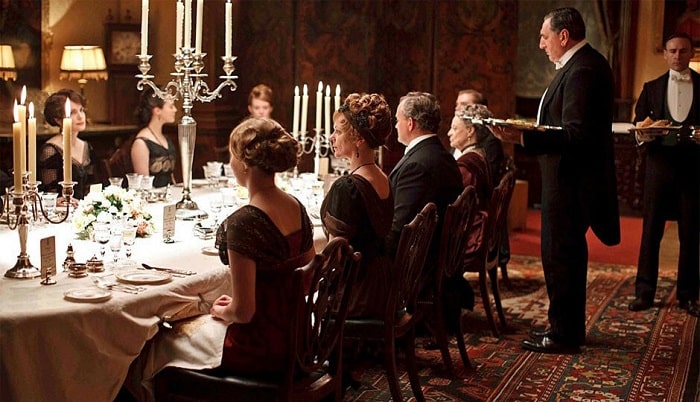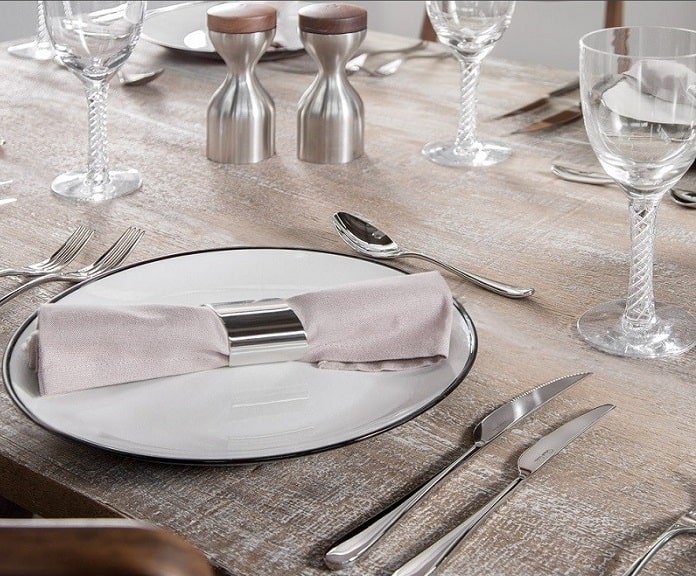Table etiquette is not a relic of the past. Good manners are always in fashion, they are always useful in life. For example, not putting your elbows on the table. This is a proven way to get people to like you and win sympathy during the meal. So how to behave properly at the table? Here are some common simple understandable rules and norms of proper behavior at the table, which will help not to lose face during a meal, whether it’s a social occasion or an ordinary dinner at a restaurant.
The basics of table culture

Knowing how to use cutlery is not too difficult a science. Each appliance has its own purpose. To avoid confusion as to which one is needed and for what purpose, start keeping a clue in your head. As new dishes are served, we move from the farthest appliance to the one next to the plate.
Let’s take a closer look at what major appliances you’ll need for different dishes:

- Cold and hot appetizers – use an appetizer fork and knife
- Appetizers in a cocotte – appetizer fork or spoon
- Hot fish – fish fork and fish knife
- Hot meat dishes – table fork and knife
- Omelets, casseroles, vegetables – table fork
- Desserts – special small dessert spoon or dessert fork.
There is an exception for minced meat dishes. If you are served a portion of cutlets, stuffed cabbage rolls or meatballs, you can get by with a single table fork.
Any meat steak or chop should be cut off in small pieces with a knife and fork. Only then, after you have chewed, can you cut the next small piece. It is considered rude to cut everything at once. In addition, then the meat cools faster and is not as tasty.
According to classic European etiquette, the knife and fork are held in both hands as long as you eat the dish. More informal American etiquette allows the knife to be placed on the edge of the plate if it is not needed at the moment. A fork is transferred to the free right hand from the left hand.
It is customary to eat first courses served for lunch with a tablespoon, taking care not to make any noise. If there are meatballs or dumplings in the soup, you won’t need a knife and fork anyway. You should use only a spoon. No one forbids finishing the soup. To do that, tilt the plate away from you and carefully pour the rest into the spoon. After that it is put back on the plate.
If you wanted to make a sandwich, a slice of bread is better placed on the patty plate. Holding the bread lightly, it is spread with a thin layer of butter. It is unhygienic to hold the bread in the palm of your hand. A piece of cheese or ham should first be poked with a fork and only then put on the bread.
You can eat bread, cakes, cookies, and almost all fruits and berries with your hands. It is not customary to take a bite of bread. One tear off a slice at a time and put it in his mouth. Pips from fruits and berries are first placed in a spoon or fork, and only then on the plate.
In the language of cutlery

If the dinner is in a restaurant, it is not unreasonable to learn and do some conventional signs, expressing a particular request. A professional waiter will easily decipher them and fulfill the request.
A fork and a knife usually lie on opposite sides of the plate with food, crossing just above the center – “I haven’t finished eating yet”. Comes in handy if you need to step away for a minute or you’re engrossed in a conversation but don’t want the dish to go away.
The fork and knife should lie perpendicularly in the center of the plate (fork upright, prongs up) – “waiting for the next dish. You need it if you are in a hurry and want to hint about it unobtrusively.
A fork and knife lying horizontally and parallel in the center of the plate, both ends on the right side – “I’m done eating, liked the food.” A little compliment to the chef and the owner of the place.
The knife and fork are crossed so that the blade goes through the tines at an angle – “I’m done eating, didn’t like the food.” Quite acceptable if you want to make a silent protest.
The fork and knife lie parallel to each other in the center of the plate at 5, 6, or 7 o’clock, both ends looking up-“I’m done eating, bring the bill.”
Under no circumstances should you place your utensils on a tablecloth or cloth napkin. This is a blatant violation of etiquette.
Table taboos

There is more to table etiquette than knowing how to use cutlery. There is a large unspoken code of table etiquette that is also best known. Here are a few more typical violations that are highly undesirable at the table.
You shouldn’t say out loud that you’re on a diet. Express your gratitude and politely refuse forbidden foods, without going into details. That goes for alcohol, too. If you don’t feel like drinking for any reason, don’t make this a big deal. Ask for a glass of juice or mineral water instead of wine.
Putting a smartphone on the table is a bad attitude. It is acceptable only if you are expecting an important call. Warn about it in advance and, when you get a call, retire to talk without attracting unnecessary attention of your neighbor and others. In other cases it is better to switch your cell phone to silent mode.
If you accidentally dropped the dishes (it doesn’t matter if it’s a guest or a restaurant), you shouldn’t get under the table. Tell them to bring you clean cutlery. If you are asked to pass a fork or spoon at the table, take it with your fingers closer to the middle, with the handle forward. The knife is passed with the handle away from you.
It is inadmissible to put a woman’s purse on a chair or her lap. She can hang it on the back of a chair or put it on the floor next to her. But a tiny clutch bag is quite acceptable to put on the table, if it will not interfere with anyone.
Toothpick is a subject of personal hygiene. Therefore, it is impossible to use it in public in any case. Wait for the right moment and go to the restroom, so that there quietly take out a piece of food left in the teeth. If you’re hosting a dinner party at home, put toothpicks in the bathroom in a prominent place.
As you can see, there is nothing burdensome or unenforceable about etiquette. Following this unspoken protocol is a simple and reliable way to show your appreciation to those who have arranged an evening or event for you with a sumptuous table. A warm, welcoming atmosphere will make it even more enjoyable.
